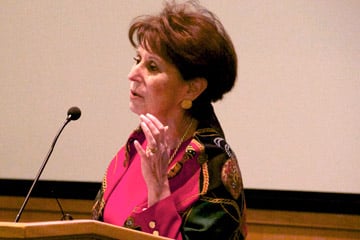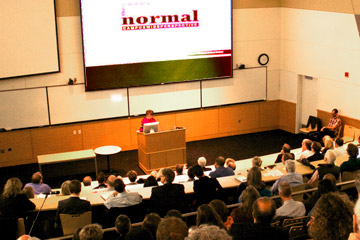 Lilly Marks, vice president for health affairs at the University of Colorado and vice chancellor of the Anschutz campus
Lilly Marks, vice president for health affairs at the University of Colorado and vice chancellor of the Anschutz campus
As the environment for academic health centers changes dramatically, the University of Colorado Anschutz Medical Campus is adapting right along with it, Lilly Marks, vice president for health affairs at the University of Colorado and vice chancellor of the Anschutz campus, said Wednesday.
This flux in funding, research and delivery, she said in her State of the Campus address, is the “new normal.”
Speaking to a crowd of about 150 at the Hensel-Phelps Auditorium on the Anschutz campus, Marks said CU is responding to challenges by improving and innovating in its key missions of research, education, clinical care and community outreach.
“Many of these projects,” she said, “will stretch us and challenge us as we adapt to new initiatives and new partnerships, building new strengths while maintaining our traditional expertise.”
She was joined for the 90-minute event by Chancellor Don Elliman, who outlined efforts to develop an advertising and marketing campaign that will allow CU Anschutz and the campus hospitals it partners with to speak with one voice about the value of the health care city that has arisen in Aurora.
“We have a great story to tell,” he said.
Elliman also discussed efforts to increase private philanthropic funding, such as the reorganization of the CU development office.
Staying in top tier of research
Marks said the new normal requires shifts in “structure and strategy across all mission areas," starting with research.
“I believe that one of our imperatives and collective goals must be to ensure that we do not fall out of the top tier of research institutions,” Marks said.
The Anschutz campus pulls in some $400 million in research annually, two-third of that from federal sources. But research funding has tightened over time. More immediately, researchers have had to cope with federal sequestration, which Marks said would cost the campus about $20 million, and the partial government shutdown that only foreshadows more political battles to come.
The Anschutz campus handles some 6,000 grants and contracts a year. Marks said faculty and staff had made clear that the system for processing those was “overwhelmed” and “fragmented.”
Beyond some recent personnel changes, she said, the entire university is assessing, through a consultant, ways to improve how it handles grants and contracts. Other initiatives to keep research humming include:
- Finding ways to accelerate the transfer of discovery from bench to bedside to marketplace.
- Partnering with industry to conduct clinical research more effectively, efficiently and successfully.
- Creating the Center for Biomedical Informatics and Personalized Medicine containing a Clinical and Research Enterprise Data Warehouse.
Marks noted that CU plans to move 20 or so staff for human resources and budget and finance from Denver offices to the Anschutz campus to better meet faculty and staff needs.

Photo: Lilly Marks delivering the State of the Campus address at the Anschutz Medical Campus. Oct. 30, 2013
Innovations by Anschutz campus programs
Marks also outlined educational innovations on campus. These include an Adolescent Dental Clinic; expansion of medical school enrollment and creation of the school’s Colorado Springs branch; and a new Leadership in Public Health master’s program.
Also, pharmacy students are helping the underserved through a Salud Family Health Centers program; nursing and public health students will have new choices of a DNP/Public Health Nursing specialty and a DNP/MPH dual degree; and the Graduate School will use a federal grant to recruit 12 highly qualified minority PhD students in the STEM disciplines.
Interprofessional education is revamping its curriculum, Marks added, and MOOCs—massive open online courses—are popping up on the Anschutz and Denver campuses.
Responses to clinical care turbulence
Marks then turned to clinical care, calling it “perhaps the most turbulent mission area in our institution.”
Some of the bumps come from the Affordable Care Act, she said, but many are caused by market dynamics and economics.
The response? All those construction cranes on the Anschutz skyline for a few years provide part of the answer. University of Colorado Hospital and Children’s Hospital Colorado built new towers and expanded services.
Another form of growth is the leap UCH has taken from stand-alone hospital to part of the University of Colorado Health system, spanning much of the Front Range with five hospitals and two affiliated hospitals, 15,000 employees, dozens of clinics, imaging facilities and urgent care.
The goal, Marks said: “A system that will provide the right care, at the right time, in the right location, at the right cost.”
Community connections in the works
Finally, Marks turned to community connections. The $4 billion Anschutz campus, on a former Army facility in Aurora, sits in one of the most economically challenged neighborhoods in the state.
“We are doing a lot” for that community, Marks said. “We have to do more.”
Marks announced that CU will support a new program designed to link campus and community. The goal is to create academic and workforce connections and launch other initiatives to serve community needs.
And efforts won’t stop there. While there have been individual initiatives, she said, “we have not provided a lot of leadership in efforts to improve the health status of our citizens around Colorado.”
So, Anschutz is exploring ideas—and grant funding—to improve health statewide, using as a model two statewide programs developed by the University of New Mexico for its state.
More fun, more shade
The campus itself is also changing.
“We pretty much value-engineered every amenity out of this campus” when it was being created, Marks said. “We need to have a campus that is fun, more friendly.”
She cited steps such as bringing food trucks to campus on Wednesdays and holding a first-ever block party attended by an estimated 2,000 people.
The new master plan for the campus also is designed to foster collaboration with what Marks called “collision spaces” where people with different interests can interact. One example: Redoing the area of prairie grass adjacent to Research 1 South to make it a gathering place. And, she said, “more shade.”
Several audience members asked Marks about how to increase revenue from new sources. Marks said that beyond reorganizing CU’s fundraising operation, she anticipated political strategies to generate dollars for the campus.
Another questioner pressed Marks for detail on how CU might make what she called the “pretty hard decisions” on what areas to focus on and fund in the “new normal.”
Marks said those choices should not be made from on high but should be “a decision of the academy.”
She asked faculty and staff on campus to continue to constructively push for change and to suggest innovations. Send ideas to CUAnschutz-ideas@ucdenver.edu.
In her remarks about the campus last year, Marks detailed the complexity and depth of the problems. This year, she said, the Anschutz focus is on action.
“We all need to adopt new skill sets and new mind sets,” Marks summed up. “We can be open to change or be victims of change.”
